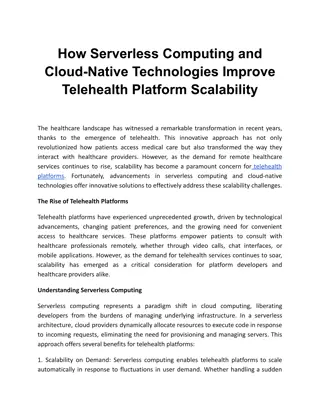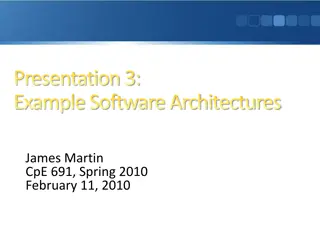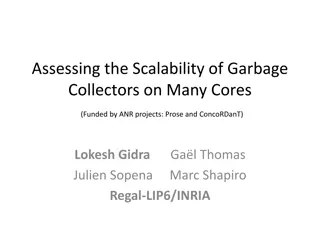
Scalable Software Architectures Lecture Highlights
Explore key topics from a lecture series on basic architecture design, authentication methods, a case study on a memorial website, and a monolithic web app API structure.
Download Presentation

Please find below an Image/Link to download the presentation.
The content on the website is provided AS IS for your information and personal use only. It may not be sold, licensed, or shared on other websites without obtaining consent from the author. If you encounter any issues during the download, it is possible that the publisher has removed the file from their server.
You are allowed to download the files provided on this website for personal or commercial use, subject to the condition that they are used lawfully. All files are the property of their respective owners.
The content on the website is provided AS IS for your information and personal use only. It may not be sold, licensed, or shared on other websites without obtaining consent from the author.
E N D
Presentation Transcript
1 CS-310 Scalable Software Architectures Lecture 11: Basic Architecture Design Steve Tarzia
2 Last Time: Authentication Webservice requests are rarely open to the public. Each request must include an input that authenticates and identifies the user. Passwords are the most common auth mechanism. Email/SMS (a trusted side channel of communication) can be used. Authentication tokens are strings randomly generated (and stored) on the backend to verify user identity. Variations include session keys, cookies, and api keys. Often a separate microservice is dedicated to authentication (and other user management tasks, like account creation).
3 Case Study: National Gun Violence Memorial https://gunmemorial.org Java servlet w/JSP, connecting to a SQL database, with S3 for images. AWS deployment uses these services: Elastic Beanstalk EC2: Elastic Compute Cloud (Virtual Machines) RDS: Relational Database Service CloudFront (CDN) Route 53 (DNS) Simple Email Service (SES)
4 NGVM architecture diagram Stripe & Paypal (donation processors) Email (SMTP) Server DNS Web App (Stateless & Monolithic) Web Scraper (run by cron) Web Browser gunviolence archive.org SQL Database talk.gunmemorial.org Discourse App (open source) S3 file store CDN Public HTTP server SQL Database S3 file store
5 Monolithic web app API: Public Pages HTML pages: GET / GET /[year]/[mon]/[day]/[name] GET /[year]/[mon]/[day] GET /about GET /search etc. HTML Form and JS endpoints: POST /doLightCandle?victim=[id] POST /doPublicPostPhoto Body: multipart/form-data: victim (int) source (string) contact (string) mine (boolean) grant (boolean) sure (boolean) file (binary image data) POST /poll/doAnswerQuestion?... POST /poll/doModerateQuestion?... POST /doDonate? stripeToken=[ ]&amount=[cents] Note that this API's design does not follow REST style. Paths specify actions, not resources. For full list of public pages, see: http://gunmemorial.org/sitemap.txt http://gunmemorial.org/sitemap.txt?start Year=2020&endYear=2020
6 Monolithic web app API: Volunteers' Portal HTML pages GET /sign-in (no cookie required, response sets a cookie) GET /admin GET /admin/victim_edit.jsp?id=[id] GET /admin/photo_edit.jsp?photo=[id] GET /admin/moderate_photos.jsp GET /admin/moderate_answers.jsp GET /admin/victim_add.jsp etc. In all these requests, require a cookie to authenticate and identify the user. HTML Form and JS endpoints: POST /admin/doAddVictim?... Query params: date (YYYY-MM-DD) city (string) province (two-letter abbreviation) name (string) gender (string) POST /admin/doChangePassword? POST /admin/doChoosePhoto? POST /admin/doEditPhoto? POST /admin/doDeleteVictim? How to rewrite this following REST design principles? Answer: DELETE /victim/{id}
7 SQL Database Schema (simplified) Arrows are foreign keys, underlines are primary keys, other keys described in italics. article_link photo_candidate url_hash id victim (index) victim (index) url photo_url title volunteer id edit_log victim name victim (index) id primary_photo email (unique) time name (index) victim passwd_hash author (index) date (index) photo photo active description city (index) id province (index) victim (index) source_url session moderation comment source_title id comment (index) id candle width user up_or_down victim (index) victim (index) height expiry_time ip_address category date cookie (unique) comment global_property ip_address ip_address key cookie value unique(victim, date, cookie)
8 S3 File Store details candidate_photo/[uuid].jpg photo/[photo_id].jpg photo_thumb/100/[photo_id].jpg photo_thumb/400/[photo_id].jpg photo_thumb/800w/[photo_id].jpg web_archive/[article_url_md5hash].html Use a randomized uuid to prevent public scan. 100px-tall thumbnail 400px-tall thumbnail 800px-wide thumbnail Copy of news article HTML (in case original article is taken down). Files have read-only public access at: https://s3.amazonaws.com/gunmemorial-media/... https://media.gunmemorial.org/... Served from Virginia. Using CDN (costs more).
9 April 2020 monthly operating cost ($136 total) S3 File Store, $9.19 DNS, $1.39 Traffic: (from Google Analytics). Typically about 150 users on the site at any given time. EC2 Virtual Machines, $16.30 CDN, $55.79 Data Transfer, $24.33 Relational DB Service, $28.77 37k pageviews per $ cost
10 CDN statistics in April
11 Deployment sizing and monthly costs Stripe & Paypal (donation processors) Email (SMTP) Server One t2.micro + 9GB = $4 One t3.small + 100GB storage = $29 DNS Web App (Stateless & Monolithic) Web Scraper (run by cron) Web Browser gunviolence archive.org SQL Database talk.gunmemorial.org One t2.nano + 8GB = $2.50 Discourse App (open source) EC2/RDS instances are reserved for one year to reduce hourly cost App and its SQL DB share a t2.micro + 35GB S3 file store CDN Public HTTP server SQL Database S3 file store storage = $6
12 Scaling up to 200x traffic (equal to cnn.com) STOP and THINK Stripe & Paypal (donation processors) Email (SMTP) Server DNS Web App (Stateless & Monolithic) Web Scraper (run by cron) Web Browser SQL Database gunviolence archive.org S3 file store CDN Public HTTP server
13 Database scaling Stripe & Paypal (donation processors) Email (SMTP) Server Add read-replicas (horizontal) Use bigger instances (vertical) Upgrade primary from t3.small r5d.24xlarge SQL Primary Web App (Stateless & Monolithic) Web Scraper (run by cron) Load balanc ing lib Web Browser Read Replicas gunviolence archive.org S3 file store CDN Public HTTP server
14 App scaling Stripe & Paypal (donation processors) Email (SMTP) Server Add lots of app servers and load balancing. SQL Primary Web App (Stateless & Monolithic) Web Scraper (run by cron) Load Balancer (reverse proxy) Load balanc ing lib Web Browser Read Replicas gunviolence archive.org S3 file store CDN Public HTTP server
15 More front-end caching Stripe & Paypal (donation processors) Email (SMTP) Server CDN in front of web app to cache HTML. CDN for all media files, even on detail pages. SQL Primary Web App (Stateless & Monolithic) Web Scraper (run by cron) Web Browser Load Balancer (reverse proxy) gunmemorial.org Load balanc ing lib CDN Read Replicas gunviolence archive.org CDN S3 file store Public HTTP server
16 Final scalable design Stripe & Paypal (donation processors) Email (SMTP) Server DNS SQL Primary Web App (Stateless & Monolithic) Web Scraper (run by cron) Web Browser Load Balancer (reverse proxy) gunmemorial.org Load balanc ing lib CDN Read Replicas gunviolence archive.org CDN S3 file store Public HTTP server
17 Can a single SQL database handle the write load? At 200x the load, we'd expect about 400k 200 = 80M events/month 80M/month 1 month/2.6M sec 30 DB writes per second This is definitely achievable: Magnetic disk can do ~100 IOPS SSD can do > 5,000 IOPS [ref.] Month of April UI events (leading to DB writes): But this is just a theoretical projection. It's better to look at the load in practice There are also DB writes to add new victims to the database, but this negligible and does not scale with traffic. Visitor actions are the main concern for scaling.
18 Empirical scaling analysis (real traffic on t3.small) Data at left is from two weeks in May 2020, running the database on a t3.small instance. Remember, our goal is to scale traffic by 200x. AWS allows DB instances with up to 32k IOPS. Can a single machine's storage handle 200x the load? Yes! 200x more load would be just 2k IOPS. The biggest DB instance available (r5.24xlarge) has 96 CPU cores instead of just two. Can a single machine's CPU handle 200x the load? Yes! Two CPU cores can handle 30x more load. 48x more CPU cores might handle 1,400x the load. On t3.small (two CPU cores)
19 NGVM is easy to scale. Why? STOP and THINK Traffic is mostly reads. Visitors are not logged in. There are no personal recommendations or user behavior models. Each user gets the same HTML, and responses can be cached in CDN. Effects of visitor actions (lighting candles, leaving comments) need not be visible immediately to other visitors. Caching is possible. Users don't interact directly with each other. No user notifications. Memorial pages are independent of each other. Data size does not scale with traffic (number of memorial pages is fixed). Legacy.com would be more difficult to scale. Writes don't involve any transactions.
20 Recap Showed NVGM architecture design case study. It's another article publishing system, so arch is similar to Wikipedia. Caching and load balancers on frontend, Stateless app, SQL DB with read-replicas. S3 file store was used for large media files (photos).






















